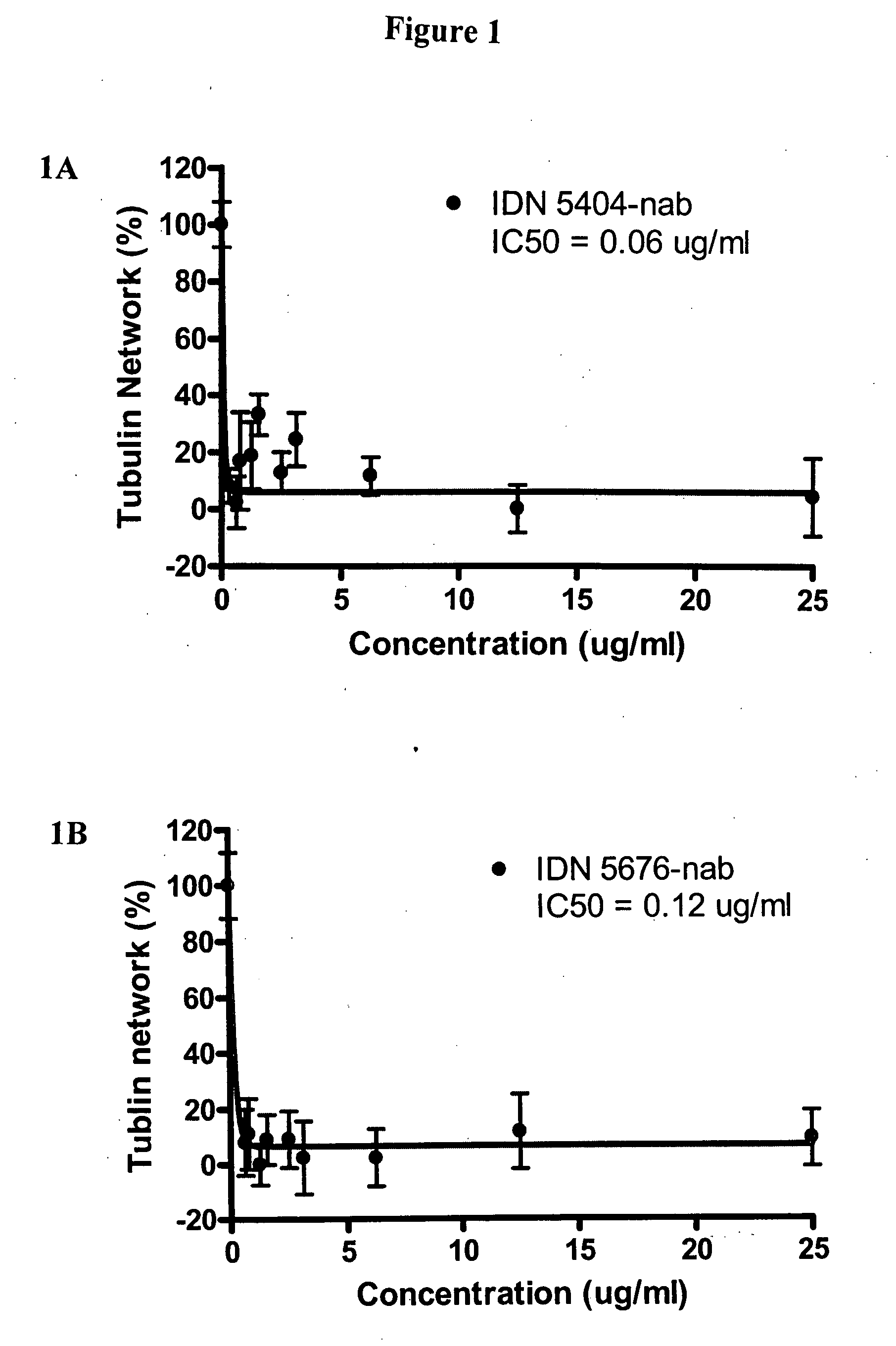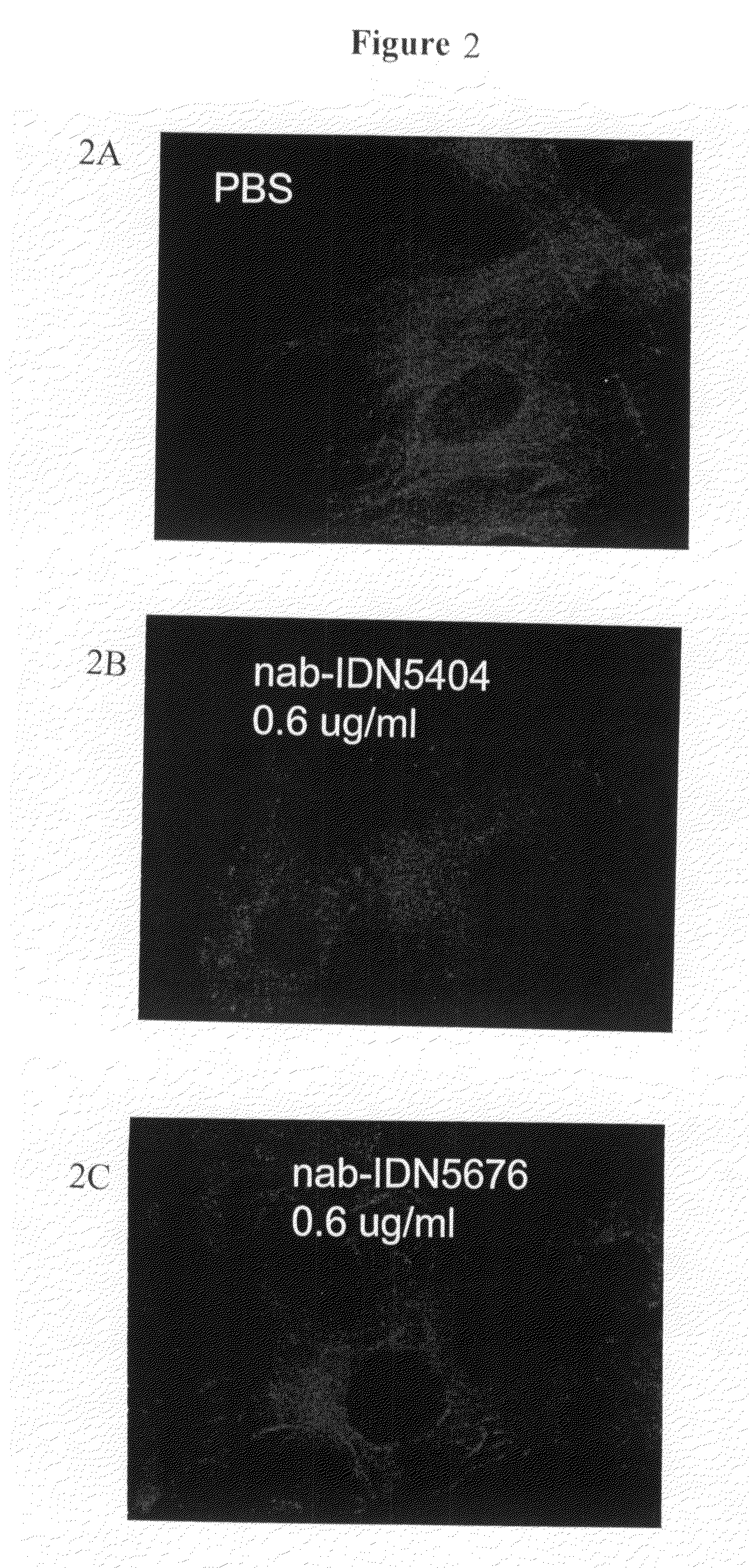Methods of inhibiting angiogenesis and treating angiogenesis-associated diseases
a technology of angiogenesis and angiogenesis, which is applied in the direction of biocide, cardiovascular disorders, drug compositions, etc., can solve the problems of occlusion of blood vessels, shutdown of blood flow, and profound alteration of cell shape, so as to inhibit angiogenesis and induce significant cytotoxicity in the individual
- Summary
- Abstract
- Description
- Claims
- Application Information
AI Technical Summary
Benefits of technology
Problems solved by technology
Method used
Image
Examples
example 1
In vitro Cytotoxity Activity of Nab-5404 and Nab-5676
[0152]The cytotoxic activities of Nab-5404 and Nab-5676 were evaluated in vitro using MX-1 breast carcinoma, HepG2 hepatoma, HT-29 colon carcinoma cell lines and normal primary rat hepatocytes. Cells were exposed to Nab-5404 and Nab-5676 for 72 hours at 37° C. across a range of increasing concentrations. Viability was analyzed using a Cell Titer Blue cell viability assay (Promega, Madison, Wis.). IC50s were calculated with a one-phase exponential decay equation using Prism software (GraphPad, San Diego, Calif.).
[0153]Nab-5404 demonstrated cytotoxic activity against HepG2 hepatoma cells and primary rat hepatocytes, with IC50s of 16 and 9 μg / ml respectively. Both Nab-5404 and Nab-5676 were moderately cytotoxic against MX-1 cells, with IC50s of 43 and 54 μg / ml respectively. Activity of Nab-5404 and Nab-5676 against HT-29 cells was low with IC50s of 110 and 149 μg / ml, respectively. Nab-5676 showed little or no cytotoxic activity in He...
example 2
Anti-microtubule Activity of Nab-5404 and Nab-5676
[0154]The microtubule depolymerization activities of Nab-5404 and Nab-5676 were tested using the MX-1 breast carcinoma cell line. MX-1 cells were seeded on cover slips and treated with Nab-5404 or Nab-5676 for 2 hours at 37° C. across a concentration range of 0.01 to 100 μg / ml. After incubation, the cells were fixed and stained for tubulin and actin. Tubulin was stained with monoclonal anti-tubulin antibody and actin was stained with fluorescein-labeled phalloidin. The microtubule network was visualized and analyzed using ImagePro Software (MediaCybernetics, Inc., Silver Spring Md.). IC50s for Nab-5404 and Nab-5676 activity on microtubule destabilization were calculated using Prism software (GraphPad, San Diego, Calif.).
[0155]Both Nab-5404 and Nab-5676 exhibited potent microtubule depolymerization activity with calculated IC50s of 0.06 μg / ml and 0.12 μg / ml, respectively (FIGS. 1A and 1B). Even at the lowest concentration tested, 0.6 ...
example 3
Anti-Angiogenic Activity of Nab-5404 and Nab-5676
[0156]To study the effect of Nab-5404 and Nab-5676 on angiogenesis, the compounds were evaluated in a microvessel formation assay using a TCS CellWorks AngioKit model (TCS CellWorks Ltd., Botolph Claydon, Buckingham UK). The AngioKit model uses human endothelial cells co-cultured with other human cells. The endothelial cells initially form small islands within the culture matrix, then begin to proliferate and then enter a migratory phase during which they move through the matrix to form threadlike tubule structures. These gradually join up to form a network of tubules which closely resemble a capillary bed (at day 9-11). The tubules stain positive for von Willebrand's factor, CD31 (PECAM-1) and ICAM-2.
[0157]In addition to Nab-5404 and Nab-5676, a known vascular targeting agent, combretastatin 4-phosphate (CA4P), was tested for in vitro anti-angiogenic activity. The TCS CellWorks AngioKit model was used according to the manufacturer's ...
PUM
| Property | Measurement | Unit |
|---|---|---|
| Fraction | aaaaa | aaaaa |
| Mass | aaaaa | aaaaa |
| Mass | aaaaa | aaaaa |
Abstract
Description
Claims
Application Information
 Login to View More
Login to View More - R&D
- Intellectual Property
- Life Sciences
- Materials
- Tech Scout
- Unparalleled Data Quality
- Higher Quality Content
- 60% Fewer Hallucinations
Browse by: Latest US Patents, China's latest patents, Technical Efficacy Thesaurus, Application Domain, Technology Topic, Popular Technical Reports.
© 2025 PatSnap. All rights reserved.Legal|Privacy policy|Modern Slavery Act Transparency Statement|Sitemap|About US| Contact US: help@patsnap.com



